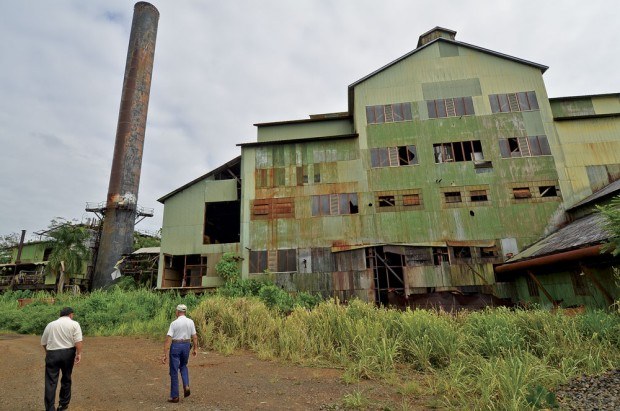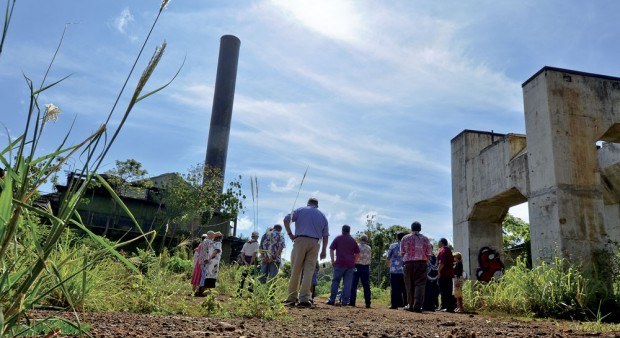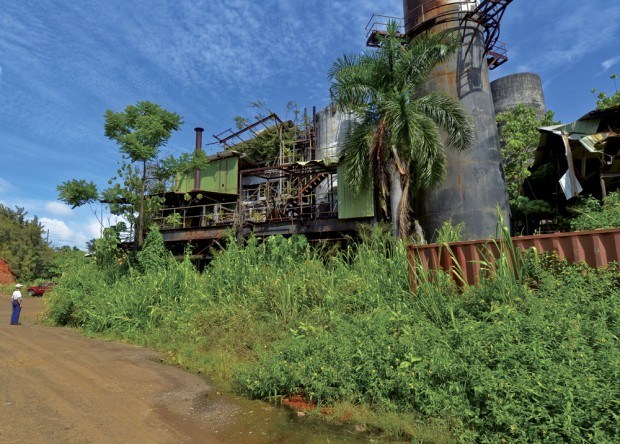LIHU‘E — Few people understood the complexity of the Lihu‘e Sugar Mill, said Lyle Tabata, the last Amfac manager on Kaua‘i. “I don’t think people realized the technology which took place inside these buildings,” said Tabata, who now serves as
LIHU‘E — Few people understood the complexity of the Lihu‘e Sugar Mill, said Lyle Tabata, the last Amfac manager on Kaua‘i.
“I don’t think people realized the technology which took place inside these buildings,” said Tabata, who now serves as deputy county engineer. “We had the best trades people in the state and I would be proud to stack any of them against anyone in the state. The old-timers passed on the knowledge so I could run this place, and today, in the county, I feel confident when faced with the hundreds of problems.”
Tabata, who also bid farewell to the former Kekaha Sugar Mill Tuesday, was among the guests who gathered Wednesday between the Lihu‘e sugar mill and its power generation unit. The group blessed the site with aloha before work begins to raze the asbestos-laden and corroding structures.
Kumu Maka Herrod officiated the ceremony, asking people to consider Hawaiian values starting with ‘ohana, pono, kuleana, aloha and mahalo in their reflections, remembrance and bestowing of aloha.
“I never thought I would outlive the mill,” said Fred DeBusca who worked at the mill for 48 years.
He started working there when he was 14 years old and retired after suffering a heart attack.
“Ninety years of sugar,” he said. “I don’t know how many times I climbed those stairs.”
Herrod said the place was born in 1849, and in 1934 the mill was erected.
“I am acutely aware the town existed because of the placement of the mill,” said Pat Griffith, president of the Lihu‘e Business Association. “Every time we visit our neighbors at the cemetery, especially in the morning, we would see the shadow of the stack and the three smaller stacks of the power generation unit spanning the graveyard.”
Alton Miyamoto, a third generation sugar worker, said he came to build the power generation unit, agreeing with DeBusca about not believing he would outlive the mill.
“There are lessons to be learned about technology in sugar,” Miyamoto said. “The plantation was totally self-sufficient. The plantations built all the hydro systems.”
State Sen. Ron Kouchi, growing up in the plantation camp of Makaweli, described the health system which grew from the plantation’s decisions to care for its workers. He noted the work wagons where the plantation camp residents would get in and go to work.
While running for political office, he remembers Kaena Nakamoto who spoke to him about fighting for people in the sugar industry.
“We were known as the Black Foot Kids,” said Bobby Girald. “The Lihu‘e Grammar School was up where the Department of Water is today and there used to be a foot-and-a-half of black soot on the ground. Even if you wore long pants, you would get black.”
Girald said everybody worked for the plantation, which gave so much to so many people.
“It was challenging beause if something was needed, there was no Home Depot; you had to make it,” Girald said.
Despite these challenges, Jan TanBruggencate, author of the Lihu‘e Mill history, said Lihu‘e Plantation processed more cane than any other mill in the state and was the most advanced of any in Hawai‘i.
“It built the town of Lihu‘e, the heart of Kaua‘i,” he said.
Similarly, Kaua‘i Mayor Bernard Carvalho Jr. remembers the connection his family had with the plantation. His father started as a cane haul truck driver, advancing to lineman, and his aunts and uncles were part of the workforce. He also recalled the smoke on burn days, which came into the house and wasn’t considered an environmental concern.
State Rep. Derek Kawakami, D-14th District, whose mother Arlene spoke of the nightly curfews for youngsters, said the stack is like the Eiffel Tower of Lihu‘e.
“We tend to take things for granted until we lose them,” Kawakami said. “I recollect the sounds, smells of growing up in Ulu Mahi, and running around in this area and listening to the ghost stories and playing in the irrigation ditches. Even if my hands aren’t dirty from sugar, it is woven into the fabric of my life.”
DeBusca said when he started working, he only had an elementary school education, but by studying at the kitchen table for three years, he was able to get his high school diploma through the GED program and went on for three years of college.
“I started as a blacksmith’s helper and worked up to becoming the chief engineer,” DeBusca said. “When we needed to go up the stack, they would winch us up and down, but after Vietnam, the helicopters would take us up and down. But it was still a scary experience because the stack would sway at least a foot-and-a-half each way.”
Kawakami said the ‘aina has the opportunity to provide for the generations to come, just as the plantation, in its 150-year span, took care of several generations of people.
“I appreciate what PAHIO Resorts is doing because no one else would,” Tabata said. “But a piece of us will always be left here.”
• Dennis Fujimoto, photographer and staff writer, can be reached at 245-3681 (ext. 253) or dfujimoto@ thegardenisland.com.




